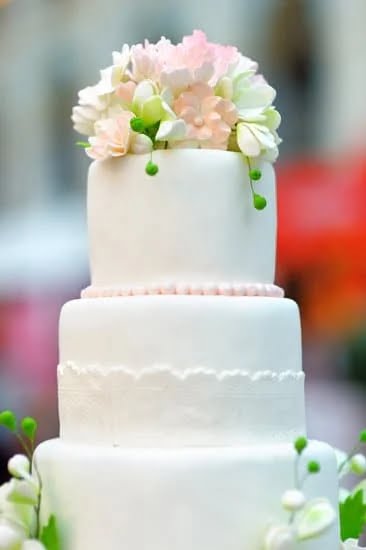Cake decorating is a delightful art form that brings joy to both the creator and the recipient. From grand wedding cakes to adorable birthday treats, the intricately designed confections never cease to amaze. One crucial aspect of cake decorating that often captivates enthusiasts is the attention to detail. Every stroke of icing, every carefully placed adornment contributes to the overall visual appeal. Among these minute details are tiny dots on extension work, which possess a charm of their own.
Every cake decorator understands the significance of precision and intricacy in their craft. It is through meticulous attention to each design element that an ordinary cake can be transformed into a masterpiece. Extension work, one of the fundamental techniques in cake decorating, involves adding delicate elements such as borders, lacework, or filigree designs onto the surface of a cake. These extensions provide an opportunity for decorators to showcase their talent and creativity.
Amongst the various techniques employed in extension work, tiny dots shine brightly with their simplicity yet versatility. These miniature spheres hold immense power in terms of visual impact and aesthetic appeal when utilized thoughtfully. Whether used as decorative accents or as part of intricate patterns, these tiny dots add texture and dimension to any cake design.
But what exactly are these minuscule wonders called? In this article, we delve into the world of dot piping techniques and explore different terms used to refer to these enchanting additions on extension work.
Understanding the Basics
Cake decorating is an art form that captivates both professional bakers and hobbyists alike. The ability to transform a plain cake into a stunning masterpiece with intricate designs never fails to mesmerize. One aspect of cake decorating that requires skill and attention to detail is extension work.
Extension work involves creating delicate and intricate decorations, typically made from royal icing or gum paste, that are added onto the surface of a cake. These decorations can range from simple borders to elaborate floral arrangements and other intricate designs. Extension work adds dimension, texture, and visual interest to a cake while showcasing the decorator’s creativity and talent.
The significance of extension work lies in its ability to elevate cakes from ordinary to extraordinary. It allows decorators to bring their artistic visions to life by incorporating unique and personalized elements into their designs. Whether it’s adding delicate flowers, lace patterns, or precisely piped lines, extension work gives decorators endless possibilities to create one-of-a-kind cakes that amaze and delight.
Mastering extension work requires practice, patience, and a good understanding of different piping techniques. It also necessitates a keen eye for detail as tiny dots play an integral role in this form of cake decorating. In the next section, we will explore why these tiny dots are essential in extension work as well as the different terms used to refer to them.
The Beauty of Tiny Dots
Tiny dots may seem like a minor detail in cake decorating, but they hold immense visual appeal and provide versatility in enhancing the overall design of a cake. These tiny dots can add depth, texture, and dimension to extension work, making the cake truly stand out. In this section, we will explore the beauty of tiny dots in cake decorating and discuss their various applications.
Visual Appeal of Tiny Dots
The visual impact created by tiny dots on a cake cannot be underestimated. When placed strategically, these small details can create a stunning visual effect that catches the eye. Whether used to form intricate patterns or to accentuate specific elements on a cake, tiny dots draw attention and add interest to the overall design. They provide an opportunity for creativity, allowing decorators to experiment with different colors, sizes, and placement techniques to achieve various effects.
Versatility of Tiny Dots
One of the most remarkable things about tiny dots is their versatility in cake decorating. They can be used across various styles and themes ranging from elegant wedding cakes to whimsical children’s birthday cakes. Tiny dots are not limited to any specific shape or color; they can be round, square, or even irregular shapes depending on the desired design.
Furthermore, dot piping can be employed for different purposes like creating polka dot patterns, mimicking floral petals or even turning them into more complex designs like lacework. With such versatility at hand, decorators have infinite possibilities when incorporating tiny dots onto their creations.
The beauty of tiny dots lies not only in their appearance but also in the skill required to create them with precision and consistency. Dot piping techniques vary depending on the decorator’s preference and creativity. In the next section, we will explore different piping techniques utilized by decorators to master the art of creating flawless tiny dots on extension work.
What Are Tiny Dots on Extension Work Called?
Extension work in cake decorating often involves adding intricate details and designs to create a visually stunning cake. One of the most captivating aspects of extension work is the use of tiny dots. These small, delicate dots not only add depth and dimension to the cake design but also demonstrate the baker’s attention to detail and precision.
Tiny dots on extension work can be referred to by various terms, depending on the specific technique used or the desired effect. Some common terms used to describe these dots include:
- Piping Dots: Piping dots involve using a piping bag fitted with a small round tip to create uniform, perfectly round dots on the cake. This technique requires steady hand movements and controlled pressure on the piping bag to achieve consistent results.
- Pearl Dots: Pearl dots are similar to piping dots but are created using pearlized fondant or edible pearls. These tiny beads add an elegant touch to cakes and create a subtle shimmering effect.
- Stippling: Stippling refers to creating dots by repeatedly tapping a brush or tool onto the cake surface, resulting in a textured dot pattern. This technique can help achieve a more organic and natural look, adding depth and texture to the overall design.
- Royal Icing Dots: Royal icing dots are made by applying royal icing – a mixture of powdered sugar and egg whites – onto the surface of the cake using a piping bag or small spatula. These dots dry hard, making them ideal for delicate flowers or fine details that require stability.
Creating perfect tiny dots requires practice and attention to detail. Here are some techniques that bakers commonly employ:
- “Wet-on-wet” technique: This method involves piping wet icing onto wet icing, allowing the colors to blend seamlessly while creating tiny dots for a cohesive design.
- “Drybrushing” technique: By lightly brushing dry food coloring powder onto dried royal icing or fondant surfaces, bakers can create subtle and realistic shading effects with tiny dots.
To achieve consistent and precise results, bakers rely on essential tools such as small round piping tips, icing bags, toothpicks or scribe tools for fine details, and brushes for stippling. These tools help maintain control over the size and shape of the dots while ensuring uniformity throughout the design.
Professional bakers have honed their skills to create flawless tiny dots on extension work by following some expert tips and tricks. These include practicing on parchment paper before decorating a cake, using a light touch to pipe dots, applying a steady pressure when stippling, and experimenting with different techniques and sizes of piping tips to achieve various dot effects.
Tiny dots can be used in a multitude of creative ways to enhance cake designs. From delicate floral patterns to intricate lace details or even whimsical polka dots, these small elements add elegance, texture, and visual interest to every cake. Whether you are a professional baker or an enthusiastic home baker looking to elevate your cake decorating skills, mastering the art of creating perfect tiny dots on extension work will undoubtedly take your creations to new heights.
Dot Piping Techniques
First and foremost, dot piping is a popular technique in cake decorating that involves creating small, uniform dots on extension work. There are several different techniques that cake decorators use to achieve these tiny dots, each with its own unique effect. One common technique is using royal icing, which is piped through a small round tip onto the surface of the cake.
This allows for precise control and creates neat and evenly spaced dots. Another technique is using buttercream frosting and a small round piping tip to pipe individual dots onto the cake. This method can create slightly larger dots with a softer texture.
In addition to traditional piping techniques, there are also alternative methods to create tiny dots on extension work. One such method is using edible markers or pens to draw the dots directly onto the cake. This technique can be quicker and easier, especially for beginners or those who prefer a more freehand approach.
Another option is using fondant or gum paste shaped into tiny balls and attached to the cake with edible glue or water. This method can add dimension and texture to the design while still achieving the desired dot effect.
Regardless of which technique you choose, it’s important to practice beforehand and experiment with different sizes, colors, and patterns of dots to find what works best for your desired design. Being patient and having a steady hand are key skills when it comes to creating precise and uniform tiny dots on extension work. With practice and attention to detail, you’ll be able to master these dot piping techniques and elevate your cake decorating skills to new levels.
| Piping Technique | Description |
|---|---|
| Royal Icing | Using royal icing piped through a small round tip for precise control |
| Buttercream Frosting | Using a small round piping tip to pipe individual dots with a softer texture |
| Edible Markers or Pens | Directly drawing the dots onto the cake with edible markers or pens |
| Fondant or Gum Paste Balls | Shaping fondant or gum paste into tiny balls and attaching them to the cake for added dimension and texture |
Common Tools for Dot Piping
Cake decorating requires a variety of tools and equipment to achieve precise and uniform tiny dots. These tools not only help in creating flawless designs but also make the process easier and more efficient. Here are some common tools used for dot piping in cake decorating:
- Piping Bags: Piping bags are essential for holding the icing or frosting that will be used to create the tiny dots. They come in different materials such as plastic, cloth, or disposable options, each with its own advantages. Plastic bags are durable and easy to clean, while disposable bags eliminate the need for washing after use.
- Decorating Tips: There are a wide range of decorating tips available specifically designed for creating dots of different sizes. Round tips are commonly used for small to medium-sized dots, while larger round tips can be used for bigger dots. It’s important to select a tip that matches the desired size and shape of the dots.
- Couplers: Couplers allow you to change decorating tips without having to empty and refill the piping bag. This is especially useful when working with different colors or sizes of dots in a design. Couplers consist of a base that attaches to the piping bag, and a ring that secures the tip in place.
- Gel Food Coloring: Gel food coloring is preferred over liquid food coloring because it does not alter the consistency of the icing as much. When creating tiny dots, it’s important to work with icing that holds its shape well, so gel food coloring is ideal for achieving vibrant colors without compromising texture.
- Practice Boards or Sheets: Practice boards or sheets are helpful tools for honing your dot piping skills before working directly on a cake. These flat surfaces provide smooth practice areas where you can experiment with different techniques and perfect your dot placement.
By using these essential tools and equipment, cake decorators can achieve precise and uniform tiny dots on their extension work. However, it’s also important to keep in mind that practice, patience, and attention to detail are key in mastering the art of dot piping. As you experiment with different techniques and tools, you’ll soon be able to create stunning designs that incorporate these exquisite tiny dots.
Tips and Tricks for Perfect Dots
Creating flawless tiny dots on extension work requires skill and precision. Here are some expert tips and tricks to help you master this art:
- Use the right consistency: Achieving the perfect dot begins with having the right consistency of icing or frosting. For dot piping, it is important to have a medium consistency icing that holds its shape but is still easy to pipe. If the icing is too stiff, it will be difficult to pipe smooth dots, while if it is too runny, the dots will spread and lose their shape.
- Practice pressure control: Controlling the pressure while piping is crucial for creating consistent dots. Start with a small amount of pressure on the piping bag and gradually increase it as you pipe each dot. This will help maintain uniformity in size and shape of the dots.
- Hold the piping bag correctly: Properly holding the piping bag can greatly influence your ability to create perfect dots. Hold the bag at a 90-degree angle with your dominant hand gripping near the tip and your other hand supporting near the top for stability. This grip allows for better control over pressure and helps achieve clean and precise dots.
- Experiment with different piping tips: Different piping tips produce different dot sizes and textures. Experiment with various tip sizes such as round tips or star tips to create different effects on your extension work. Remember to test each tip on a separate surface before applying them to your cake to get a feel for how they perform.
- Practice on a flat surface first: Before attempting dot piping directly onto your cake, practice on a flat surface like parchment paper or wax paper. This will allow you to refine your technique, build muscle memory, and ensure consistent results when working on your actual cake.
- Maintain steady hands: Steady hands are essential for creating perfect dots. Resting both arms on a stable surface while piping can help minimize any shaking or trembling movements that can affect dot accuracy. If needed, use a turntable to spin the cake while piping to maintain a steady hand position.
By applying these expert tips and tricks, you will be well on your way to creating flawless tiny dots on your extension work. Remember, practice makes perfect, so don’t be discouraged if it takes a few attempts to achieve the desired results. With time and patience, you will master this exquisite technique and add a touch of elegance to your cake designs.
Creative Examples
Creative Examples: Showcasing Stunning Cake Designs
Cake decorating is an art form that allows for endless creativity and imagination. One of the most captivating techniques within this art is the use of tiny dots on extension work. These minuscule dots can add a touch of elegance, whimsy, or sophistication to any cake design. In this section, we will explore some stunning examples of cakes that beautifully incorporate these tiny dots.
Vintage Elegance
A popular theme for wedding cakes, vintage elegance combines intricate detailing with a dash of nostalgia. One gorgeous example features a three-tiered cake with delicate lace patterns in pastel shades. Tiny white dots are carefully piped onto the lacework, creating a mesmerizing effect reminiscent of traditional embroidery. These tiny dots add depth and dimension to the overall design, elevating it from ordinary to extraordinary.
Whimsical Wonderland
For those seeking a more playful and whimsical cake design, incorporating colorful tiny dots can bring the desired effect to life. Imagine a cake adorned with bright fondant flowers and quirky characters from fairy tales. The addition of tiny multicolored dots scattered throughout the design adds an element of fun and whimsy. These dots give the impression of confetti or fairy dust sprinkled around the enchanting scene.
Edible Artistry
Some cakes transcend ordinary confectionery and become bona fide works of art. Intricate hand-painted designs showcased on a perfectly frosted canvas are awe-inspiring creations sure to delight any art enthusiast. The use of tiny gold or silver metallic dots delicately placed within an elaborate painting adds opulence and richness to the overall masterpiece.
These examples merely scratch the surface when it comes to incorporating tiny dots on extension work in cake decorating. The possibilities are limited only by one’s imagination and skill level.
Whether aiming for a classic touch of elegance, a whimsical wonderland, or an exquisite edible art piece, the careful placement of tiny dots can transform any cake into a show-stopping centerpiece. Let these examples inspire you to experiment and explore the world of cake decorating with this remarkable technique.
Conclusion
In conclusion, the art of cake decorating is truly a fascinating and rewarding endeavor that requires great attention to detail. Throughout this article, we have explored the beauty and significance of tiny dots in cake decorating, specifically on extension work. These intricate details not only add visual appeal but also showcase the skill and precision of the decorator.
The versatility of tiny dots in cake decorating cannot be overstated. Whether they are used to create delicate patterns or add dimension to a design, these small details elevate the overall aesthetic of a cake. From polka dots to floral accents, tiny dots can bring any theme or concept to life.
Understanding and mastering the techniques involved in creating tiny dots is key to achieving professional-looking results. Through dot piping techniques and utilizing common tools, decorators can achieve precise and uniform dots. Moreover, with practice and expert tips, decorators can perfect their dot-piping skills.
To further illustrate the potential of tiny dots on extension work, numerous creative examples have been highlighted throughout this article. These stunning designs serve as inspiration for readers to explore their own creativity and experiment with incorporating tiny dots into their own cake decorating projects.
Frequently Asked Questions
How to make polka dots on a cake?
To make polka dots on a cake, start by baking and cooling your cake completely. Next, prepare your desired colors of frosting in piping bags fitted with small round tips. Hold the piping bag perpendicular to the surface of the cake and gently squeeze out small dots of frosting.
Repeat this process with different colors in a random or patterned arrangement until you achieve the desired look. You can also use tools such as stencil templates or round cutters as guides for more precise placement of polka dots. Allow the frosting dots to set before serving or further decorating the cake.
How do you make frosting dots?
Making frosting dots is quite simple and adds a delightful touch to any dessert. Begin by preparing a batch of your preferred frosting recipe, ensuring that it is a stiff consistency suitable for piping. Transfer the frosting into a piping bag fitted with a small round tip, such as Wilton tip #5 or #6.
Hold the bag perpendicular to the surface you want to decorate and apply gentle pressure while squeezing out small circles or dots of frosting onto your dessert. Continue this process until you have created the desired number and size of dots. Practice applying consistent pressure to achieve even-sized dots, and remember that you can always practice on parchment paper before moving onto your final creation.
What are cake decorating balls called?
Cake decorating balls are commonly referred to as “pearls” or “dragees.” These small decorative edible spheres are often used to add texture, elegance, and interest to cakes, cupcakes, cookies, and other baked goods. Dragees typically come in various sizes, colors (such as silver or gold), and finishes (such as matte or metallic).
They may be made from sugar coated in a hard shell or consist of edible metals like gold or silver leafing applied through a specialized technique called electroforming. When using dragees in cake decorating, they can be attached individually using edible glue or placed in arranged patterns using tweezers for precision placements.

Welcome to our cake decorating blog! My name is Destiny Flores, and I am the proud owner of a cake decorating business named Cake Karma. Our mission is to provide delicious, beautiful cakes for all occasions. We specialize in creating custom cakes that are tailored specifically to each customer’s individual needs and tastes.





